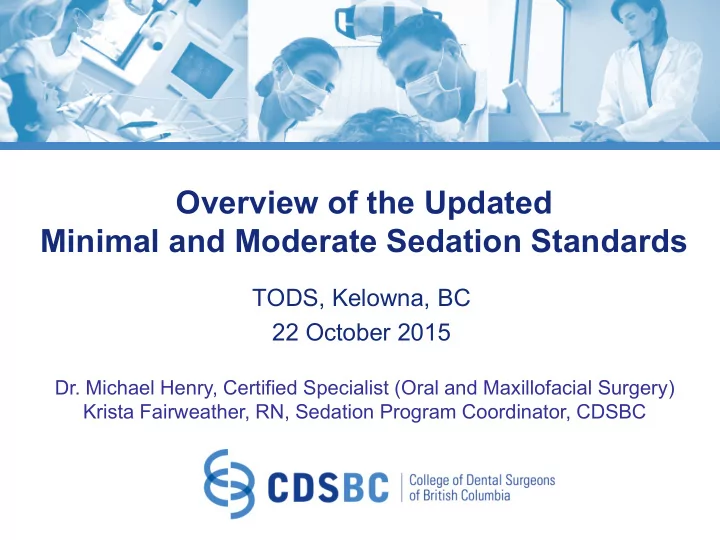

Overview of the Updated Minimal and Moderate Sedation Standards TODS, Kelowna, BC 22 October 2015 Dr. Michael Henry, Certified Specialist (Oral and Maxillofacial Surgery) Krista Fairweather, RN, Sedation Program Coordinator, CDSBC
Introduction Objectives Agenda: Minimal sedation • What is it? • Requirements • Team, Equipment • Pre, Intra, Post-op Moderate sedation • What is it? • Requirements • Team, Equipment • Pre, Intra, Post-op 2
Evolution of the Sedation Document 3
Public Consultation Process • 20 Drafts • 100 organizations & individuals E-published August 2014 4
What is Minimal Sedation? 5
Minimal Sedation Registration is not required but there are educational requirements • Single oral drug • Nitrous Oxide/Oxygen • Combining single oral drug with Nitrous Oxide/Oxygen 6
The Team Minimum 2 individuals • Dentist with appropriate training and current certification in BLS for health care provider (CPR-HCP) • Appropriately trained staff member with current certification in BLS for health care provider (CPR-HCP) Recommended to run mock drills every 6 months 7
Equipment • Ventilation apparatus or BVM • Emergency medication kit (Appendix C) • Oxygen and suction equipment • AED is highly recommended 8
Required Emergency Medications 9
Pre-operative Evaluation/Requirements • Medical history • Informed consent • Review of systems • Dietary restrictions • Medication use • Verbal and written instructions • ASA Status • Baseline vitals • BMI and Stop Bang highly recommended • Focused physical evaluation 10
Intra-operative Requirements • Vitals evaluated and monitored as clinically indicated • Anaesthetic record must be maintained • Monitoring must include: o oxygenation o ventilation o circulation 11
Post-operative Requirements • Patient monitored until discharge criteria are met (Appendix N) • Dentist must determine and document LOC, oxygenation, ventilation and circulation are satisfactory prior to discharge • Post-operative verbal and written instructions (Appendix J) • Patient must be accompanied home by a responsible adult 12
What is Moderate Sedation? 13
Oral (Enteral) Moderate Sedation Registration is required • Multiple oral drugs o With or without Nitrous Oxide/Oxygen • Didactic – 40 hrs. • Patient experiences – sedation and concurrent dental treatment on 20 patients 14
Parenteral Moderate Sedation Registration is required Level 1 benzodiazepine drugs only Level 2 authorization to add a narcotic 15
Parenteral Educational Requirements Level 1 • Didactic – 60 hrs. • Patient experiences – the dentist must place the IV, administer the sedation and provide concurrent dental treatment on 20 patients (single drug) • Cannot be shared experiences 16
Parenteral Educational Requirements Level 2 • Must first hold Level 1 authorization • Complete 150 cases and submit log to CDSBC • Complete additional clinical training through same program as Level 1 • Patient experiences - the dentist must place the IV, administer the sedation and provide concurrent dental treatment on 20 patients o (2 drug) 17
College Process Application with supporting documentation Sedation & GA Services Committee Approved Denied Request for more information 18
The Team • Three individuals: o Dentist with appropriate training, authorization and current ACLS o RN or hygienist, CDA with additional sedation training o Third member must have current BLS (CPR-HCP) • Must run mock drills every 6 months 19
Equipment • Ventilation apparatus or BVM • Emergency medication kit (Appendix D) • Oxygen and suction equipment • AED • Airway management equipment (Appendix K) • physiologic monitor • emergency suction machine • Intravenous equipment and supplies (Appendix O) (for IV sedation) 20
Required Emergency Medications 21
Pre-operative Evaluation/Requirements • Medical history • Informed consent • Review of systems • Dietary restrictions • Medication use • Verbal and written instructions • ASA status • Baseline vitals • BMI • Focused physical • Stop Bang evaluation 22
Intra-operative Requirements • Continuous Pulse Oximetry • BP at least every 15 minutes • Anaesthetic record must be maintained • Monitoring must include: o oxygenation o ventilation o circulation o consciousness 23
Post-operative Requirements • Patient monitored until discharge criteria are met (Appendix N) • Dentist must determine and document LOC, oxygenation, ventilation and circulation are satisfactory prior to discharge • Post-op verbal and written instructions (Appendix J) • Patient must be accompanied home by a responsible adult 24
Facility Inspections • All offices must be equipped to current standard • Parenteral moderate facilities will be inspected and must be registered with CDSBC 25
“Before anything else, preparation is the key to success” - Alexander Graham Bell 26
Contact sedation@cdsbc.org
Recommend
More recommend